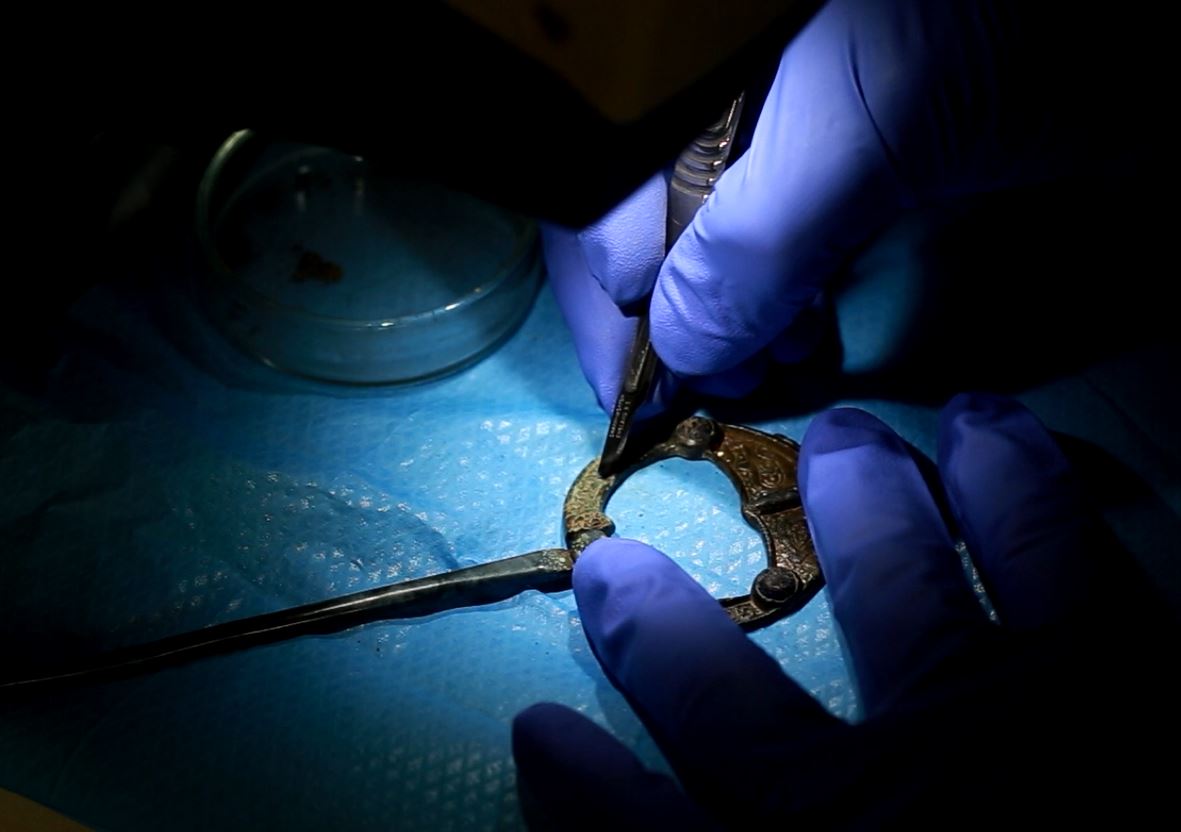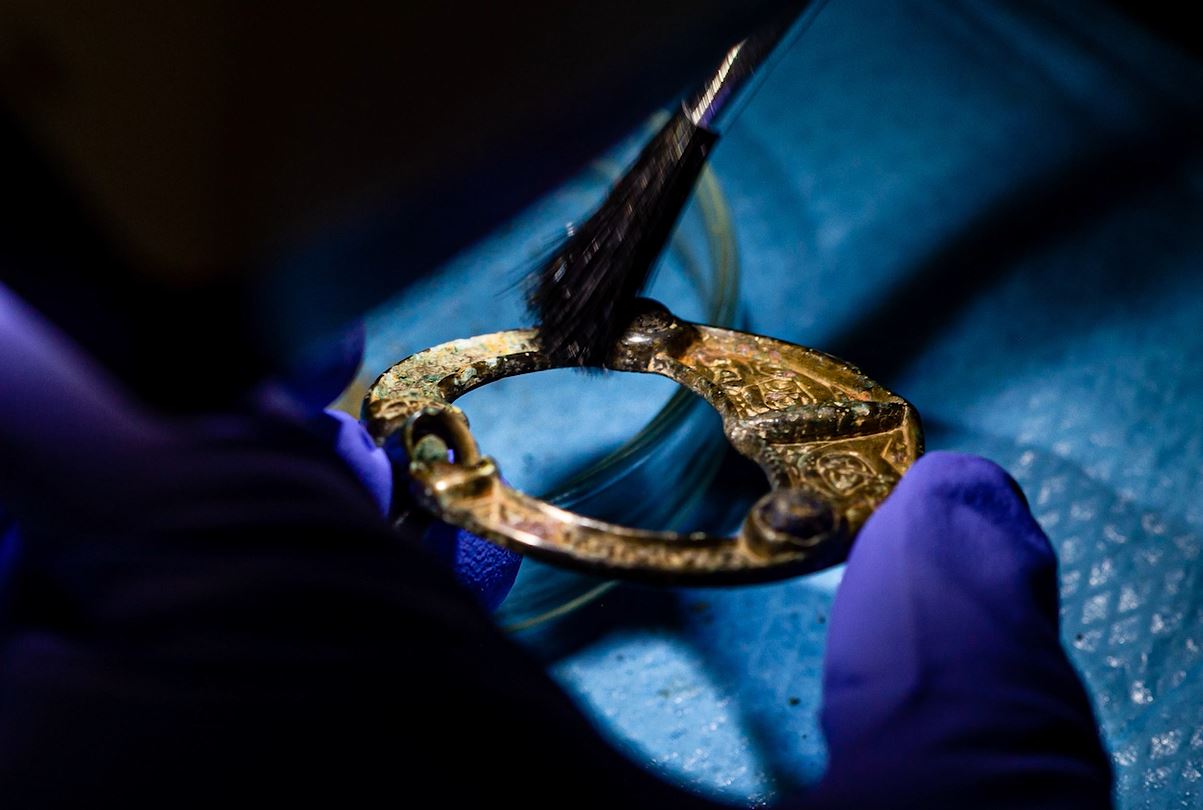Seoid a Cailleadh Athaimsithe: Dealg Ard an tSeanbhaile
Le Mara Tesorieri, Susannah Kelly, agus John Channing

Déardaoin, an 25 Iúil 2024, bhí an seandálaí Jimmy Dobson ag tochailt coda trí líonadh dhíog imfhálaithe nua-aitheanta, ag suíomh a ainmníodh Ard an tSeanbhaile 1 ar bhealach Sheachbhóthar Áth Dara i gContae Luimnigh, nuair a d’aimsigh sé dealg chré-umha 1200 bliain d'aois. Leagann an réad atá maisithe go hálainn béim ar stádas roinnt de na daoine a bhí ina gcónaí cois Inbhear na Sionainne sna luath-mheánaoiseanna agus ar a gcuid saineolais ar mhiotalóireacht. Tá sé ar cheann de na samplaí is fearr den chineál seo deilge a ndearnadh caomhnú orthu a aimsíodh le linn tochailt seandálaíochta in Éirinn le blianta fada. Mar thoradh ar cháilíocht an réada, roghnaigh coimeádaithe in Ard-Mhúsaem na hÉireann é lena chur san áireamh i mórthaispeántas de sheoda luath-mheánaoiseacha na hÉireann – Friotail thar Farraige..
Ó thús 2024, tá seandálaithe ó Archaeological Management Solutions (AMS) ag déanamh imscrúduithe seandálaíochta réamh-fhoirgníochta feadh an Tionscadail Bhóthair ó Fhaing go Luimneach. Tá an scéim bóthair 34 km seo, lena n-áirítear Seachbhóthar Áth Dara, suite ó dheas ó Inbhear na Sionainne (Léaráid 2). Téann an bóthar nua trí thírdhreach saibhir stairiúil ina bhfuil dáileadh dlúth suntasach de ráthanna ón luath-Mheánaois (an 5ú go dtí an 12ú haois AD) sna ceantair thuaithe, agus bailte tábhachtacha Angla-Normannacha amhail Áth Dara agus Eas Géitine. Tugadh an-aire le linn chéim deartha an tionscadail chun an tionchar ar shéadchomharthaí aitheanta seandálaíochta agus ar shuíomhanna aitheanta stairiúla a íoslaghdú. Mar sin féin, mar is amhlaidh i gcás gach tionscadal forbartha, bhí an fhéidearthacht ann suíomhanna seandálaíochta nach raibh doiciméadaithe roimhe seo a nochtadh. Dearadh na tochailtí seandálaíochta réamh-fhoirgníochta a rinne AMS thar ceann Chomhairle Cathrach agus Contae Luimnigh agus Bhonneagar Iompair Éireann (BIÉ) chun imscrúdú córasach a dhéanamh ar an talamh a fuarthas chun bóithre a thógáil, ionas go bhféadfaí aon suíomh seandálaíochta nach raibh doiciméadaithe roimhe seo a shainaithint agus a thochailt i bhfad sula dtosófaí ar oibreacha tógála. Mar thoradh ar na tochailtí seo, thángthas ar níos mó ná 140 suíomh seandálaíochta nár taifeadadh roimhe seo, ag nochtadh fianaise ar ghníomhaíocht dhaonna ón réamhstair go dtí an nua-aois. Tá imfhálú Ard an tSeanbhaile 1 inar aimsíodh an dealg ar cheann de na suíomhanna sin nár taifeadadh roimhe seo, ach is fiú a thabhairt faoi deara gur dócha go gcaomhnaíonn an logainm, leagan galldaithe d’Ard an tSeanbhaile a chiallaíonn ‘ardáit an tseanbhaile’, cuimhne an phobail ar lonnaíocht ársa sa cheantar seo.

Ba é imfhálú ciorclach díogtha c.22m ar trastomhas inmheánach an ghné seandálaíochta is suntasaí a nochtadh ag Ard an tSeanbhaile 1. Bhí an díog carraig-ghearrtha go páirteach agus bhí sí idir 2 m agus 3.40 m ar leithead agus idir 0.88 m agus 1.60 m ar doimhneacht. Fuarthas deighleog de dhíog sheachtrach chomhlárnach ar thaobh thiar thuaidh di. Níor aithníodh aon bhealach isteach, caithfidh go raibh sé suite sa chuid theas den imfhálú nach bhfuil tochailte go fóill. Ná níor tháinig aon fhianaise ar bhanc inmheánach slán, is dócha gur treabhadh é ó bhí daoine lonnaithe sa suíomh go deireanach breis is mílaois ó shin. Líon beag claiseanna agus lorg cuaille, ba iad sin na gnéithe seandálaíochta amháin a mhair laistigh den limistéar iata. Mar sin féin, tugann an líon mór cnámha ainmhithe (cnámha eallaí, muc agus caorach) a fuarthas ón díog imfhálaithe le fios go raibh gníomhaíocht intíre laistigh den imfhálú. Chomh maith leis an dealg, aisghabhadh roinnt réada seandálaíochta eile le linn na tochailte, lena n-áirítear bioráin fháinneacha agus roithleán eiteáin maisithe a bhí déanta as beanna.
Bhí imfhálú Ard an tSeanbhaile 1 suite ag ceann thuaidh d’iomaire íseal óna bhfuil radharc ar Abhainn na Máighe agus a tuilemhá san iarthar (Léaráid 3–5). Fuarthas imfhálú ciorclach luathmheánaoiseach eile, An Currach Beag 1, ar an iomaire ar an taobh eile de ghleann na habhann. Bhí radharc ón dá shuíomh ar a chéile agus toisc go raibh moirfeolaíocht an dá shuímh comhchosúil is dócha gur bhain siad leis an tréimhse chéanna. B'fhéidir go raibh siad suite mar seo ionas go bhféadfadh áititheoirí iontu súil a choimeád ar a raibh ag teacht is ag imeacht ar an abhainn.
Tar éis í a thochailt go cúramach, rinneadh an dealg a phacáistiú, a bhaint den láthair agus a thabhairt chuig áiseanna iar-thochailte AMS, áit inar tógadh grianghraf di agus inar tomhaiseadh í. Tá dhá ghné den dealg; ceann ciorclach na deilge (fonsa) atá 4.36cm ar trastomhas agus an dealg féin atá 12.88cm ar fad. Cuireadh Ard-Mhúsaem na hÉireann ar an eolas faoin bhfionnachtain agus seachadadh an dealg chuig áiseanna caomhnaithe an Mhúsaeim, áit inar aithin Raghnall Ó Floinn, iar-Stiúrthóir Ard-Mhúsaem na hÉireann, an réad mar dhealg a bhain leis an naoú haois. Rinne Paul Mullarkey (speisialtóir um chaomhnú miotal agus anailís eolaíoch, Ard-Mhúsaem na hÉireann), Fluaraiseacht X-Ghathach (XRF) ar an dealg agus ar a comhpháirteanna chun an cineál miotail nó miotal as a ndearnadh í a fháil amach. Chuir léamha feadh aghaidh agus chúl cheann na deilge, agus feadh na deilge féin, torthaí comhchosúla ar fáil, ag léiriú go raibh an dealg déanta as cré-umha teilgthe (copar den chuid is mó, le mionleibhéil luaidhe agus stáin).



Thosaigh Susannah Kelly ag caomhnú na deilge, ag déanamh measúnú tosaigh agus taifeadadh ar a riocht, sula ndearna sí cinneadh maidir leis na cóireálacha a bhí riachtanach (Léaráid 6). Nuair a scrúdaíodh í faoi mhicreascóp, sainaithníodh dhá stoda gloine ghorma, dhá ionsáiteán ómra agus roinnt snáithíní teicstíle i measc agus faoi bhun an chreimthe. Tá salainn chopair tocsaineach do mhiocrorgánaigh. Ós rud é gurb iad miocrorgánaigh an phríomhchúis le scriosadh ábhair orgánacha, tá seans ann go mairfidh aon ábhar orgánach atá i dteagmháil le réad cré-umha. Dá bhrí sin, is minic a fhaightear iarsmaí adhmaid, leathair agus teicstíle i gcomhar le déantáin den sórt sin. Sa chás seo, d’fhan roinnt snáithíní ceangailte le barr na deilge agus is dócha go mbaineann siad leis an earra éadaigh ar ar caitheadh an dealg.
Rinneadh an dealg a ghlanadh ar dtús trí úsáid a bhaint as maipíní d'alcól íon (Biotáillí Meitileacha Tionsclaíocha) chun aon ithir agus táirgí creimthe a bhí ceangailte go scaoilte léi agus a chlúdaigh na gnéithe maisiúla gloine agus ómra a bhaint go bog (Léaráid 7). Bhí na hionsáiteáin ómra ilroinnte agus ag scaradh ón dromchla. Nuair a glanadh iad seo, comhdhlúthaíodh iad le Paraloid B-72 (greamachán agus comhdhlúthán aicrileach de ghrád caomhnaithe atá go hiomlán inchúlaithe agus inbhainte más gá). Bhí na stodaí gloine brataithe le Paraloid freisin chun iad a chosaint le linn ghlanadh na gcodanna miotail.


Baineadh na snáithíní teicstíle ó bharr na deilge le teanchair mhín tar éis na táirgí creimthe timpeall orthu a bhogadh le heatánól. Is féidir anailís ar leithligh a dhéanamh orthu sin agus iad a athcheangal nuair is gá.
Agus na comhpháirteanna ábhair eile faoi chosaint, bhí sé sábháilte anois na dromchlaí miotail a ghlanadh. Baineadh úsáid as sceanóg, scuab ar a raibh guairí gloine agus maipíní Bhiotáillí Meitileacha Tionsclaíocha chun screamha dlútha a chlúdaigh an dromchla mhiotail a bhaint (Léaráid 8 agus 9). Rinneadh an obair go léir ag úsáid micreascóp déshúileach. Nochtadh dromchla maisithe faoi bhun na dtáirgí creimthe, agus seachas roinnt spotaí ina raibh tionchar galar agus spuaiceanna cré-umha le sonrú ar an dromchla, bhí an dromchla foriomlán i riocht measartha maith.


Nuair a bhí na dromchlaí glanta, bhí sé riachtanach an réad a chóireáil go ceimiceach chun stop a chur le próiseas an ghalair chré-umha. Chuige seo, dí-ghréisceadh an dealg in aicéatón agus tumadh í faoi fholús i dtuaslagán Benzotriazole (BTA) i mBiotáillí Meitileacha Tionsclaíocha ar feadh 48 uair an chloig. Ansin, sruthlaíodh go maith í chun BTA iarmharach a bhaint agus triomaíodh í go bogthaise choibhneasta an-íseal ar feadh ocht n-uair an chloig i gcuasán triomadáin. Nuair a baineadh go leor taise as an miotal, séalaíodh é in Incralac, ar bratú cosanta sainfhoirmle é le haghaidh réada cré-umha. Is cosaint i gcoinne taise é seo toisc go mbíonn taise ina cúis le hathghníomhachtú phróiseas creimthe an ghalair chré-umha. Tá an dealg níos sábháilte anois, níos cobhsaí agus in ann tuilleadh staidéir, anailíse agus taispeána a sheasamh.
Nuair a glanadh an dealg, nochtadh dearadh casta ar aghaidh cheann na deilge, ina raibh patrúin mhíolchruthacha le sonrú ar phainéil chuasaithe, agus stodaí gloine agus ionsáiteáin ómra le sonrú idir gach painéal. Níl aon mhaisiúchán ar chúl na deilge (Léaráid 10 agus 11). Is cosúil go léiríonn na dearaí míolchruthacha ar an dá ‘theirminéal’ beithígh ag baint greim as a neireabaill féin (anailís bhreise ag teastáil chun é seo a dheimhniú). Tá cruth liontóideach ardaithe 1.6cm ar fad ar na ‘teirminéil’, ag déanamh aithris b’fhéidir ar stoda gloine nó ómra, agus tá dhá mhaisiú bheaga chuartha mar fhráma timpeall orthu (Léaráid 11 agus 12). Tá dhá mhórstoda gloine ghorma idir na painéil ‘theirminéalacha’ agus an fonsa, stodaí a chríochnaíonn an ceann ciorclach. Tá an fonsa 0.62cm ar leithead, agus tá a dhromchla cuasaithe maisithe le dearaí ribíní atá ardaithe agus fite fuaite ina chéile. Ag barr na fáinne maisiúla, tá foircinn an fhonsa ceangailte le barra caol, a chuirtear idir dhá ionsáiteán ómra Dchruthacha (Pláta 13). Rinneadh barr na deilge a leacú agus a lúbadh timpeall an bharra chúing ag cruthú inse. Tá corp na deilge cruinn agus tá bior barrchaolaithe ag a bun.
Bunaithe ar chruth agus ar dhearadh na deilge, is dócha go dtéann sí siar go dtí an naoú haois, agus go dtéann fionnachtana eile a aimsíodh sa líonadh díge, lena n-áirítear coirnín gloine beag cruinneogach, siar go dtí an naoú haois freisin.



Tá an dealg á tarraingt faoi láthair ag maisitheoir AMS Elaine Lynch, sula gcuirfear ar taispeáint í sa taispeántas Friotail thar Farraige. Tar éis an taispeántais, déanfaidh Conor Newman, Léachtóir Sinsearach in Ollscoil na Gaillimhe agus speisialtóir san ealaín mhaisiúil agus íocónagrafaíocht luath-mheánaoiseach, anailís iomlán ar an déantán. Déanfaidh na speisialtóirí cuí anailís ar na réada eile a fuarthas ag Ard an tSeanbhaile 1, lena n-áirítear na snáithíní a aisghabhadh ón dealg, na bioráin fháinneacha, an roithleán eiteáin, an coirnín gloine chomh maith leis na hiarsmaí de chnámha ainmhí, fioghual agus plandaí dóite, agus beidh siad in ann cur síos mionsonraithe a dhéanamh orthu agus comparáidí mionsonraithe a dhéanamh idir iad agus fionnachtana den chineál céanna ó Éirinn agus níos faide i gcéin. Cuideoidh an teolas seo, mar aon leis na taifid tochailte agus an clár um dhátú radacarbóin, atá ar siúl faoi láthair, le tuiscint mhionsonraithe a shaothrú ar an saol in Ard an tSeanbhaile le linn thréimhse na luath-mheánaoise agus tá súil againn go dtabharfaidh sé léargas ar an gcúis gur cuireadh an píosa eisceachtúil seodra uaslathach seo sa díog imfhálaithe.
Tuilleadh Eolais
Chun an t-eolas is déanaí a fháil maidir le dul chun cinn na n-imscrúduithe seandálaíochta réamh-fhoirgníochta feadh an Bhóthair ó Fhaing go Luimneach agus dul chun cinn na hanailíse iarthomhaltais leanúnaí, lean cuntais meán sóisialta AMS (Facebook, Instagram, Youtube, agus Linkedin, chomh maith le seiceáil isteach ar shuíomh gréasáin AMS.
Chun an dealg a fheiceáil i bpearsa, ná caill amach ar an taispeántas nua spreagúil ‘Friotail thar Farraige: Éire agus Naomh Gallen san Eoraip sa Luath-Mheánaois’ a bheidh ar siúl ag ArdMhúsaem na hÉireann ón 30 Bealtaine go dtí an 25 Deireadh Fómhair 2025. Is féidir tuilleadh eolais a fháil ar shuíomh gréasáin an Ard-Mhúsaeim.